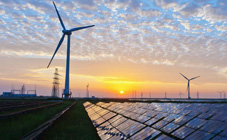On the issue of Georgiaís energy independence
By Levan Abramishvili
Wednesday, April 24


There are various methods of generating energy and every one of them has its strength and weaknesses. The thermal power plants (TPPs) that use coal and fossil fuels arenít renewable but provide guaranteed electricity supply.
TPPs are less environmentally sound than the renewable sources of energy, such as wind, solar and small scale hydro resources. They produce electricity with no greenhouse gas emissions at the point of generation and low amounts of greenhouse gas emissions across their entire lifecycle.
On the surface, the cost of electricity generation from many renewables tends to be higher than other forms of generation, but when environmental and social aspects of power generation and the costs of emissions, worsening of health and climate change are considered, the overall costs turn out to be much less. Therefore experts around the globe are advising the countries to invest more in the renewables.
According to the Ministry of Energy website, the richest of the natural resources in Georgia is the hydro supplies Ė ďaround 300 rivers are significant in terms of energy production; their total annual potential capacity is equivalent to 15000 MW, while the average annual production equals to 50 bln. KWh.Ē There are over 60 potential HPP projects identified by the Ministry of Energy; the list is public and available on the website of the Ministry.
Georgian rivers are characterized by seasonality, which implies that the vast hydro resources might not be available during the colder months, which creates a need for importing electric energy from the neighboring countries.
The use of electric energy rises yearly in Georgia, and the increase of the internal resources isnít able to keep up with the demand, which creates the need for generating energy by the thermal power stations and the necessity of importing electric energy, which, in turn, raises the tariffs for the consumers.
During the months when the rise of the water levels in rivers, excess energy is produced, and Georgia exports the electric power to neighboring Russia, Armenia, Azerbaijan, and Turkey. But during the colder months, the country needs additional energy. Unfortunately, the numbers for imported energy are higher than exported energy.
Georgia being unable to generate enough electric energy for its citizens creates several issues. One of the most apparent problems is being energy dependent upon the neighbors, especially Russia.
While it is vital to supply the country with the sufficient energy, it should be managed in an environmentally stable manner that takes into account the long-term effects of the hydro plants, their impact on the natural biome as well as on the society.
Exploiting the natural resources for the gain of the country and the businesses is one thing, but doing it in a way that directly affects the communities that are dependent upon the water resources is another.
The recent events in Pankisi Gorge is not a rally against the energy independence of Georgia, but the desperate plea of people whose livelihood is directly linked with the natural resources around them, which could be in danger if the uncontrolled construction of HPPs continues in the area.
